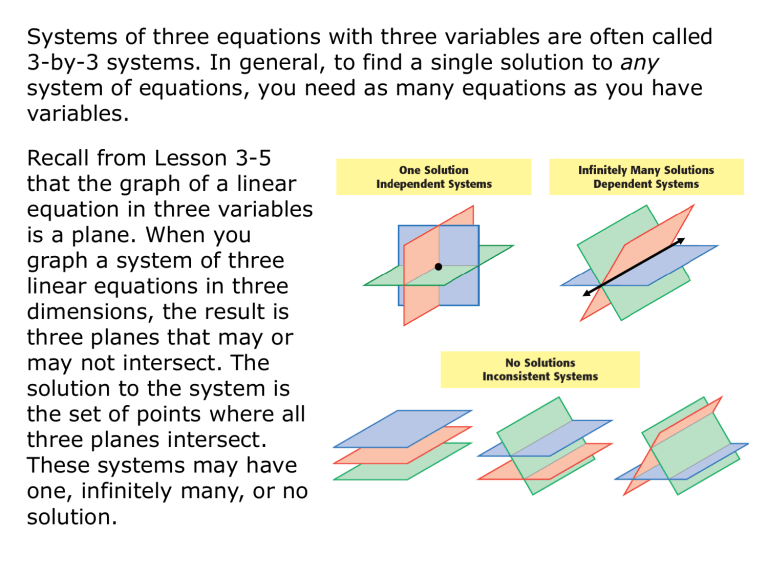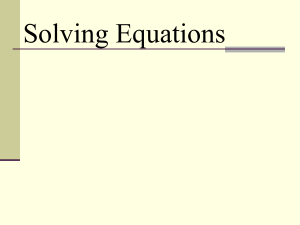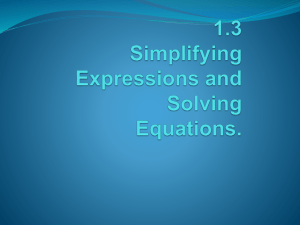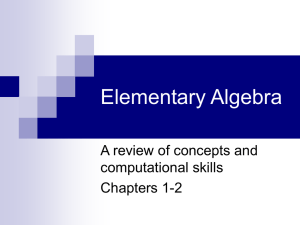3.6 - Bryan City Schools

Systems of three equations with three variables are often called
3-by-3 systems. In general, to find a single solution to any system of equations, you need as many equations as you have variables.
Recall from Lesson 3-5 that the graph of a linear equation in three variables is a plane. When you graph a system of three linear equations in three dimensions, the result is three planes that may or may not intersect. The solution to the system is the set of points where all three planes intersect.
These systems may have one, infinitely many, or no solution.
Identifying the exact solution from a graph of a 3-by-3 system can be very difficult. However, you can use the methods of elimination and substitution to reduce a 3-by-3 system to a 2-by-2 system and then use the methods that you learned in Lesson 3-2.
Ex 1: Use elimination to solve the system of equations.
5x – 2y – 3z = –7
2x – 3y + z = –16 2
3x + 4y – 2z = 7
1
3
Step 1 Eliminate one variable.
In this system, z is a reasonable choice to eliminate first because the coefficient of z in the second equation is 1 and z is easy to eliminate from the other equations.
1
2
3
2
5x – 2y – 3z = –7
3( 2x –3y + z = –16 )
5x – 2y – 3z = –7
6x – 9y + 3z = –48
Multiply equation
11x – 11y = –55
4
Use equations and to create a second equation in x and y.
3 2
3x + 4y – 2z = 7
2( 2x –3y + z = –16 )
1
3x + 4y – 2z = 7
4x – 6y + 2z = –32
Multiply equation
7x – 2y = –25
5
You now have a 2-by-2 system.
11x – 11y = –55 4
7x – 2y = –25
5
4
5
Step 2 Eliminate another variable. Then solve for the remaining variable.
You can eliminate y by using methods from Lesson 3-2.
–2(
11(
11x – 11y = –55
7x – 2y = –25 )
) –22x + 22y = 110
77x – 22y = –275
Multiply equation
- by –2, and
55x = –165
1 and add.
Step 3 Use one of the equations in your 2-by-2 system to solve for y.
4
11x – 11y = –55
11 (–3) – 11y = –55 y = 2
Step 4 Substitute for x and y in one of the original equations to solve for z.
2
2x – 3y + z = –16
2 (–3) – 3 (2) + z = –16
z = –4
1
The solution is (–3, 2, –4).
1
You can also use substitution to solve a 3-by-3 system. Again, the first step is to reduce the 3-by-3 system to a 2-by-2 system.
Ex 2: The table shows the number of each type of ticket sold and the total sales amount for each night of the school play.
Find the price of each type of ticket.
Orchestra Mezzanine Balcony Total Sales
Fri 200 30 40 $1470
Sat
Sun
250
150
60
30
50
0
$1950
$1050
Step 1 Let x represent the price of an orchestra seat, y represent the price of a mezzanine seat, and z represent the present of a balcony seat.
Write a system of equations to represent the data in the table.
200x + 30y + 40z = 1470
1
Friday’s sales.
250x + 60y + 50z = 1950
2
Saturday’s sales.
150x + 30y = 1050
3
Sunday’s sales.
A variable is “missing” in the last equation; however, the same solution methods apply. Elimination is a good choice because eliminating z is straightforward.
Step 2 Eliminate z.
Multiply equation by 5 and equation by –4 and add.
1 5( 200 x + 30 y + 40 z = 1470 )
2
–4( 250 x + 60 y + 50 z = 1950 )
1000
–1000 x x
+ 150
– 240 y y
+ 200
– 200 z z
= 7350
= –7800 y
By eliminating z, due to the coefficients of x, you also eliminated x providing a solution for y.
Step 3 Use equation to solve for x.
3
Step 4 Use equations or to solve for z.
2
3
150 x + 30 y = 1050
150 x + 30 (5) = 1050
1 200 x + 30 y + 40 z = 1470 x = 6
200 (6) + 30 (5) + 40 z = 1470
z = 3
The solution to the system is (6, 5, 3). So, the cost of an orchestra seat is
$6, the cost of a mezzanine seat is $5, and the cost of a balcony seat is $3.
Ex 3: Classify the system as consistent or inconsistent, and determine the number of solutions.
2x – 6y + 4z = 2
–3x + 9y – 6z = –3
5x – 15y + 10z = 5
1
2
3
The elimination method is convenient because the numbers you need to multiply the equations are small.
First, eliminate x.
1
2
3( 2x – 6y + 4z = 2 )
2( –3x + 9y – 6z = –3 )
6x – 18y + 12z = 6
–6x + 18y – 12z = –6
0 = 0
1
3
Multiply equation by 5 and equation by –2 and add.
3
5( 2x – 6y + 4z = 2 ) 10 x – 30 y + 20 z = 10
–2( 5x – 15y + 10z = 5 ) –10 x + 30 y – 20 z = –10
0 = 0
Because 0 is always equal to 0, the equation is an identity. Therefore, the system is consistent, dependent and has an infinite number of solutions.








